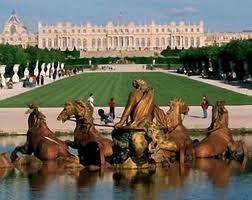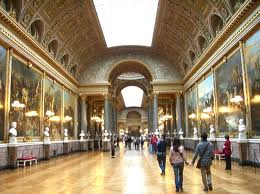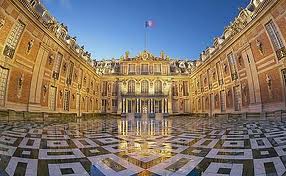The Château de Versailles is one of the largest palaces on earth and is synonymous with wealth, luxury and elegance. It is also one of the most visited châteaux in France, and, at only half an hour away from Paris, it is the perfect destination for a day trip.
Situated 10 miles southwest of Paris, the Palace of Versailles was originally meant to be only a humble hunting lodge commissioned by Louis XIII. However his son Louis Louis XIV, aka “the Sun King”, decided to abandon the Louvre in favor of building a palace at Versailles.
In 1682 Louis XIV and his court, entourage, servants, hundreds of horses and hunting dogs, and much of the royalty's possessions moved to Château de Versailles. The scale and decor of the palace reflect the absolute power of the French monarchy, then at the height of its glory and it is certain that Louis XIV meant to impress.

Louis XIV's decision to flee the filth of Paris for his sprawling château was a rather clever move, even if it was unintentional. His nobles were forced to move to Palace of Versailles as well thereby being under the watchful eye of the Sun King and consolidating his absolute power.
The roomy chambers at the château permitted a rather large Court to reside close to the King. The Palace of Versailles would be crowded with up to 10,000 (though some 3,000 lived there), which provided varied society and strict hierarchy.
But not all people inhabited Château de Versailles out of birthright. Some had to fulfill certain social obligations, whether they preferred Versailles or not (the king's word was never questioned), others chose to reside in the palace because he wanted to obtain something or simply out of curiosity. However there was a large number that needed to earn their living. The crème de la crème of the French nobility was often present, trying to obtain favors from the master of Versailles, i.e. the king.
Up to that point, it was all mere extravagance. By Louis XVI's reign, it was utter absurdity. In other words, Marie Antoinette was involved. It takes only one visit to this royal playground to understand why the (starving) rest of the country got their culottes all up in a bunch and staged a revolution (see The Revolutions and the Napoleons).
Even today the Palace of Versailles shines with the gleam of dizzying luxury, but at least people can safely visit without the prospect of beheading.

The Château de Versailles is famed for having over 2,100 windows, 700 rooms, almost twice as many fireplaces, over 65 staircases and the Galerie des Glaces, aka as the Hall of Mirrors, famous among other reasons for being the room where the Versailles Treaty was signed in 1919, effectively ending the First World War.
A large number of renown artists, including the likes of Coysevox, and Mansart designed statues and fountains fitted in Versailles’s gardens, but André Le Nôtre, the court's famous gardener projected the general plan.
Today the grounds remain a remarkable example of the obsessive landscaping the era was accustomed to- notice the neatly trimmed rectangular hedges lining the geometric bosquets (groves).
The Palace of Versailles offers a number of different guided tours of the gardens, but we believe the best time to visit the park is during the fabulous summer festival, called Les Grandes Eaux Musicales (the Great Musical Water Fountains). Check out the Festivals page for more information.
You can also hire a bicycle if you want to see the far reaches of the gardens.

There are several ways to get to Versailles from Paris, all of them quick and relatively cheap. Take the SNCF train from Montparnasse to Versailles-Chantier or the RER C line (Paris Rapid Transit) to Versailles Rive Gauche. Once at the Château de Versailles there is a choice of tickets and guides to be made.
The basic ticket and the Passeport both include an English-language audio guide and allow tourists to roam freely through the palatial state apartments, the chapel, the Dauphin’s (the prince's) apartments and several galleries.
But the Passeport grants additional access to the Grand Trianon and the Grandes Eaux Musicales fountain displays in high season.
The Chateau de Versailles opens its doors from Tuesday to Sunday, with the exception of some French public holidays. The opening times are 9 am to 6.30 pm from May to September and from 9 am to 5.30 pm the rest of the year.